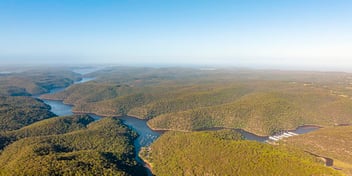World Rivers Day: addressing sediment export across transboundary watersheds

Rivers are increasingly at risk, particularly due to pollution, but new research highlights how international agreements can improve the management of transboundary watersheds, advocating for greater collaboration and coordination.
World Rivers Day (22 September) is all about celebrating the world’s waterways, highlighting the many values of rivers while striving to increase public awareness and encourage the improved stewardship of rivers around the world.
To mark the day, Source caught up with Griffith University Australian Rivers Institute’s Dr Caitlin Kuempel about a recent study looking at transboundary watersheds – main river basins that cross multiple country borders – to determine how sediment export produced in one country could reach and impact neighbouring countries downstream.
The research team identified approximately 1,050 transboundary watersheds globally. More than 85% of countries have a transboundary watershed, and in more than 25% of countries all watersheds were transboundary.
Across 112 of the transboundary watersheds identified, the majority of sediment export originated in a different country than the country where it was discharged into receiving water bodies.
“The challenge we're looking at is how rivers that cross multiple countries can create significant water quality issues,” Kuempel said.
“When sediment, silt and sand move from the land into waterw0ays, they can affect water quality, which has effects on downstream habitats, species, water availability and even human health.
“Our research focuses on the impact of sediment export on freshwater and marine systems, with a particular emphasis on how international agreements like the Global Biodiversity Framework can support transboundary management.
“The framework outlines overarching goals that we're all striving to achieve, but each nation tends to work independently to reach those goals. We're exploring how we can better tackle these processes that have a wider impact and require cooperation across human-made boundaries.”
Transboundary sediment export
Kuempel said inequalities arise primarily because most countries have a tendency to act in their own interest.
“This can put downstream countries at a disadvantage, particularly if there are economic disparities or political and governance differences,” she said.
“Sediment export is a natural part of the ecosystem, but human activities like deforestation or development can increase the amount of sediment entering rivers, affecting water quality.
In a transboundary context, sediment entering a waterway in one country can travel across borders, Kuempel said: “This can happen as sediment in rivers crosses country borders or when sediment reaches coastal areas potentially crossing exclusive economic zones”.
“Development and land-use changes upstream can increase sediment export, which can cause problems when downstream areas are left to manage the consequences,” she said.
International agreements
As part of the research, Kuempel and colleagues have been looking at how international agreements, like the Global Biodiversity Framework, can better support transboundary water management.
“One of our recommendations is to make transboundary management targets compulsory, not optional, in global frameworks,” she said.
“We also suggest scaling up metrics on land use and water quality to a watershed level in addition to the current national level reporting. This would help capture the broader picture, as many watersheds cross multiple country borders.
Kuempel said some watersheds cross over 10 national borders: “This means it's crucial to address these issues at a larger scale to see real impact. One country might be performing well, but if the broader network – particularly countries upstream – is not, the overall success is limited".
Co-benefits for river health
Aiming to create and carry forward co-benefits in this work is key to making a difference, Kuempel said.
“Co-benefits are key. For instance, restoration efforts don’t just help biodiversity—they also reduce sediment export, sequester carbon, and create habitat for species,” she said.
“Prioritising actions that have multiple benefits is a more efficient and effective way to manage resources. This is especially important in conservation where resources are limited.
“Reducing subsidies to damaging practices and scaling up successful incentive programs could also help in managing sediment export across borders.”
But, perhaps most importantly, international collaboration is absolutely central to managing transboundary issues more effectively, Kuempel said.
“While there are many complexities to managing large areas across nations, we can achieve more together than working in silos. Resources can be misused if they're focused on one area if the upstream issues aren't being addressed,” she said.
“Effective solutions require coordination and building trust across borders to achieve these ambitious conservation targets and the overarching goal of halting and reversing biodiversity decline.”


